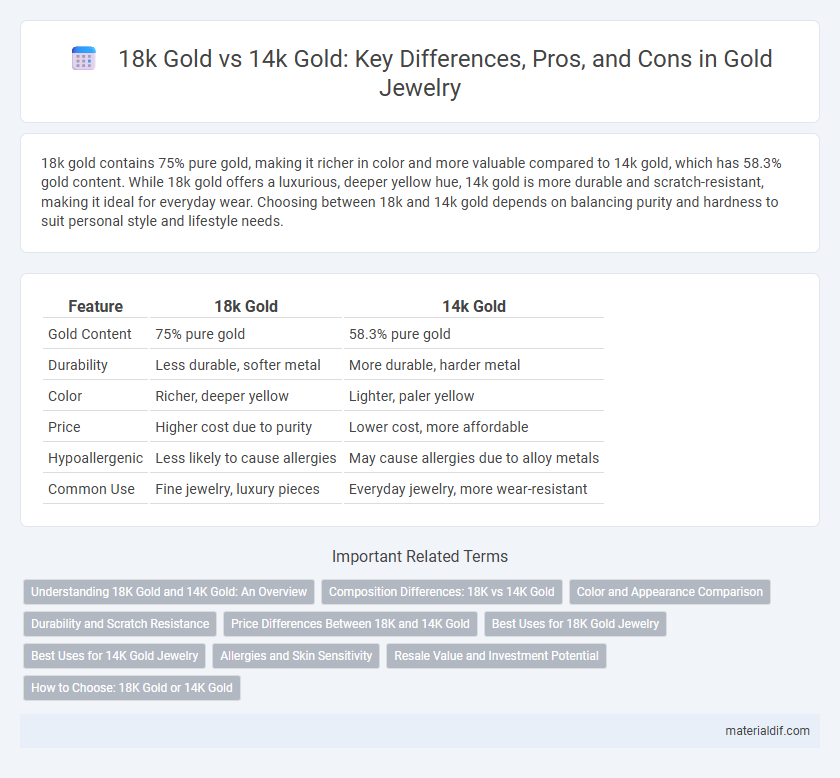18k gold contains 75% pure gold, making it richer in color and more valuable compared to 14k gold, which has 58.3% gold content. While 18k gold offers a luxurious, deeper yellow hue, 14k gold is more durable and scratch-resistant, making it ideal for everyday wear. Choosing between 18k and 14k gold depends on balancing purity and hardness to suit personal style and lifestyle needs.
Table of Comparison
| Feature | 18k Gold | 14k Gold |
|---|---|---|
| Gold Content | 75% pure gold | 58.3% pure gold |
| Durability | Less durable, softer metal | More durable, harder metal |
| Color | Richer, deeper yellow | Lighter, paler yellow |
| Price | Higher cost due to purity | Lower cost, more affordable |
| Hypoallergenic | Less likely to cause allergies | May cause allergies due to alloy metals |
| Common Use | Fine jewelry, luxury pieces | Everyday jewelry, more wear-resistant |
Understanding 18K Gold and 14K Gold: An Overview
18K gold contains 75% pure gold mixed with 25% alloy metals, offering a richer color and higher value compared to 14K gold, which consists of 58.3% pure gold and 41.7% alloys, making it more durable and affordable. The purity levels significantly influence gold's color intensity, weight, and resistance to scratching, with 18K gold appearing more lustrous and softer, while 14K gold provides better scratch resistance suitable for everyday wear. Both options balance aesthetics and practicality but cater to different preferences in jewelry investment and maintenance.
Composition Differences: 18K vs 14K Gold
18k gold contains 75% pure gold alloyed with 25% other metals, offering a richer yellow color and higher value compared to 14k gold, which contains 58.3% pure gold and 41.7% alloy metals. The increased gold content in 18k gold results in greater softness and malleability, while 14k gold's higher alloy percentage enhances durability and scratch resistance. These composition differences influence both the appearance and longevity of jewelry pieces, making 18k gold ideal for luxury items and 14k gold suitable for everyday wear.
Color and Appearance Comparison
18k gold features a richer, deeper yellow hue due to its higher gold content of 75%, while 14k gold, containing 58.3% gold, presents a lighter, paler yellow shade. The increased alloy content in 14k gold can introduce subtle variations in color, often resulting in a less vibrant appearance compared to 18k. For jewelry seeking a warm, luxurious glow, 18k gold offers superior color intensity and smoothness in finish.
Durability and Scratch Resistance
18k gold contains 75% pure gold and 25% alloy metals, providing a rich color but slightly less durability and scratch resistance compared to 14k gold, which contains 58.3% pure gold and 41.7% alloy metals. The higher alloy content in 14k gold enhances its hardness and resistance to scratches, making it more suitable for everyday wear and active lifestyles. While 18k gold offers superior aesthetics with its deeper yellow hue, 14k gold is preferred for its balanced combination of durability and scratch resistance.
Price Differences Between 18K and 14K Gold
18K gold contains 75% pure gold, making it more expensive than 14K gold, which has 58.3% gold content. The higher purity in 18K gold results in a richer color and greater value, driving its price up compared to 14K gold. Market prices reflect this difference, with 18K gold often costing 20-30% more than 14K gold depending on the current gold spot price and craftsmanship.
Best Uses for 18K Gold Jewelry
18k gold jewelry, composed of 75% pure gold mixed with 25% alloy metals, offers a rich, warm color and higher purity, making it ideal for luxury pieces like fine rings, necklaces, and bracelets that require both beauty and durability. Its higher gold content provides better tarnish resistance and hypoallergenic properties compared to 14k gold, which contains only 58.3% pure gold. This makes 18k gold perfect for heirloom-quality jewelry that maintains its luster and value over time.
Best Uses for 14K Gold Jewelry
14K gold contains 58.3% pure gold mixed with durable alloys, making it ideal for everyday jewelry like rings, bracelets, and watches due to its hardness and resistance to scratches. It offers a good balance between affordability and gold content, providing long-lasting shine and durability without the softness of higher karat gold. 14K gold jewelry is perfect for active lifestyles and frequent wear, maintaining its appearance even under rough conditions.
Allergies and Skin Sensitivity
18k gold contains approximately 75% pure gold, making it less likely to cause allergic reactions due to its higher purity and lower presence of alloy metals like nickel, which commonly trigger skin sensitivities. In contrast, 14k gold consists of about 58.3% pure gold and a greater amount of alloy metals, increasing the risk of allergies for those with sensitive skin. Choosing 18k gold is preferable for individuals prone to metal allergies since it reduces the likelihood of irritation and skin discoloration.
Resale Value and Investment Potential
18k gold contains 75% pure gold, offering higher resale value and greater investment potential compared to 14k gold, which has 58.3% gold content. The increased purity in 18k gold results in a more desirable market price per gram, making it a better long-term asset. While 14k gold is more durable for everyday wear, its lower gold content diminishes overall investment value.
How to Choose: 18K Gold or 14K Gold
Choosing between 18k gold and 14k gold depends on factors like purity, durability, and budget. 18k gold consists of 75% pure gold, offering a richer yellow color and higher value, ideal for fine jewelry with a softer feel. In contrast, 14k gold contains 58.3% pure gold, providing greater strength and scratch resistance, making it suitable for everyday wear and active lifestyles.
18k gold vs 14k gold Infographic

 materialdif.com
materialdif.com